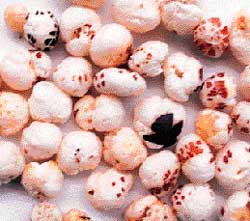Damp growth
 Many fruits and vegetables are grown in wetlands of Bihar, the most important ones being makhana and singhara. Known as foxnut, makhana (Euryle ferox) is now gaining the status of a major cash crop. Bihar accounts for 75 per cent of country's total output. The fruit has a high nutritional value. According to a report by the Council for Scientific and Industrial Research, New Delhi, it contains 9.7 per cent protein, 76.9 per cent carbohydrate, 0.1 per cent fat, 1.3 per cent minerals and 12 per cent water. It has been traditionally used to treat diseases such as beri beri and is found to be a cardiac stimulant.
Many fruits and vegetables are grown in wetlands of Bihar, the most important ones being makhana and singhara. Known as foxnut, makhana (Euryle ferox) is now gaining the status of a major cash crop. Bihar accounts for 75 per cent of country's total output. The fruit has a high nutritional value. According to a report by the Council for Scientific and Industrial Research, New Delhi, it contains 9.7 per cent protein, 76.9 per cent carbohydrate, 0.1 per cent fat, 1.3 per cent minerals and 12 per cent water. It has been traditionally used to treat diseases such as beri beri and is found to be a cardiac stimulant.
The expenditure incurred over makhana cultivation is very modest. Seeds left over from the previous year's harvest germinate as the crop for the next season. This naturally established ecosystem work for years. It is only labour that is required for thinning out the overgrowths and collecting dispersed seeds from the pond bed during harvest. No fertiliser is ever applied; the leaves from the previous year's crop act as a natural fertiliser. "We earn about Rs 5,000 to Rs 6,000 from a 164 square metre pond,' says Mukhia of Korhia village.
Madhubani and Darbhanga are the two major districts of north Bihar where makhana cultivation is undertaken on a large-scale. Due to a market demand and too many ponds in the region, some enterprising people have taken up makhana and fish cultivation in a scientific manner. Y P Thakur, secretary, Society for Rural Development, a Madhubani-based non-governmental organisation (ngo), has integrated fish and makhana farming under a project financed by the Department of Science and Technology, New Delhi. Says Thakur, "We have doubled the makhana output and this has benefited some 10,000 people directly.' Unfortunately, the guidelines for ngo initiative is stopping progressive farmers in other areas from reaping the benefits, too. "Only ngos belonging to the mallah community can take ponds on lease. This is creating a lot of corruption because some influential people have established ngos to make money by using names of some mallahs,' he says.
Singhara or water chestnut (Trapa sps) is the second aquaphyte commercially important to the wetlands of Bihar. However, it's sale is limited to the local market only as there are no organised marketing facilities. Singhara, also known as paniphal, is grown commonly in the wetlands but it grows well in any type of stagnant water in the rainy season. According to Rameshwar Sahani, a cultivator of Maillaganj, Darbhanga, a pond earns him about Rs 50 to Rs 100 daily for two months. Says Y P Thakur, "Singhara is totally neglected though it has a high nutritional value, too.' Unfortunately, the fruit is not promoted. Makhana definitely scores over singhara in terms of cultivators' choice.'
